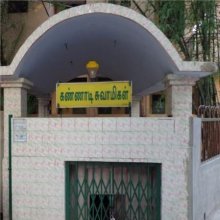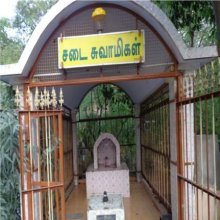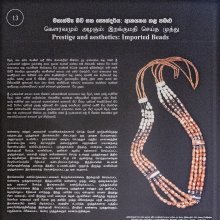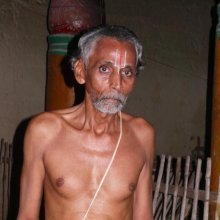Kannadi, Kaṇṇāḍi: 2 definitions
Introduction:
Kannadi means something in Hinduism, Sanskrit. If you want to know the exact meaning, history, etymology or English translation of this term then check out the descriptions on this page. Add your comment or reference to a book if you want to contribute to this summary article.
Images (photo gallery)
In Hinduism
Shilpashastra (iconography)
Source: Shodhganga: The significance of the mūla-beras (śilpa)Kaṇṇāḍi (“mirror”) refers to one of the several “attributes” (āyudha) or “accessories” of a detiy commonly seen depicted in Hindu iconography, defined according to texts dealing with śilpa (arts and crafs), known as śilpaśāstras.—The śilpa texts have classified the various accessories under the broad heading of āyudha or karuvi (implement), including even flowers, animals, and musical instruments. The other miscellaneous articles found as attributes in the hands of the deities are, for example, Kaṇṇāḍi.

Shilpashastra (शिल्पशास्त्र, śilpaśāstra) represents the ancient Indian science (shastra) of creative arts (shilpa) such as sculpture, iconography and painting. Closely related to Vastushastra (architecture), they often share the same literature.
Languages of India and abroad
Kannada-English dictionary
Source: Alar: Kannada-English corpusKannaḍi (ಕನ್ನಡಿ):—
1) [noun] the smooth surface of a metal plate or a piece of glass (coated on the reverse side with silver or an amalgam) that reflects the images of objects; a looking glass; a mirror.
2) [noun] ಕನ್ನಡಿಯ ಗಂಟು [kannadiya gamtu] kannaḍiya gaṇṭu (fig.) an impractical goal; an object desired, but practically impossible to get; ಕನ್ನಡಿಯ ಗಂಟಿಗಿಂತ ಕೈಯ ದಂಟೇ ವಾಸಿ [kannadiya gamtigimta kaiya damte vasi] kannaḍiya gaṇṭiginta kaiya daṇṭē vāsi it is better to keep what one has than to risk losing it by trying to get something better; a bird in hand is worth two in the bush.
--- OR ---
Kannaḍi (ಕನ್ನಡಿ):—[noun] the part of the face below the eye that is depressed (as from excessive eye-strain, malnutrition, etc.).
Kannada is a Dravidian language (as opposed to the Indo-European language family) mainly spoken in the southwestern region of India.
See also (Relevant definitions)
Starts with (+9): Kanati, Kannadi yele, Kannadibale, Kannadica, Kannadiga, Kannadigiti, Kannadigode, Kannadiharalu, Kannadihavu, Kannadikapatu, Kannadikarana, Kannadikayaka, Kannadisu, Kannaditi, Kannaditotti, Kannadivana, Kannadiven, Kannadividi, Kannadiya, Kannadiyele.
Ends with: Cinikkannati, Curiya-kantakannati, Curiyankannati, Kanati, Kuruttukkannati, Mukakkannati, Mukkukkannati, Nilaikkannati, Palakkannati, Putakkannati, Tura-tirushtikannati.
Full-text (+22): Amgaihunnu, Kaihunnu, Kanati, Kannati, Kannadi yele, Uruvankatti, Cinikkannati, Kattariviriyan, Vanciyartaricanam, Kannatikkatavu, Kuloppar, Kuruttukkannati, Valaiyarpaccai, Mukkukkannati, Vilankupon, Taricanai, Iracakkuntu, Nilaikkannati, Putankattu, Nilal-kanmantilam.
Relevant text
No search results for Kannadi, Kaṇṇāḍi, Kannaḍi; (plurals include: Kannadis, Kaṇṇāḍis, Kannaḍis) in any book or story.




